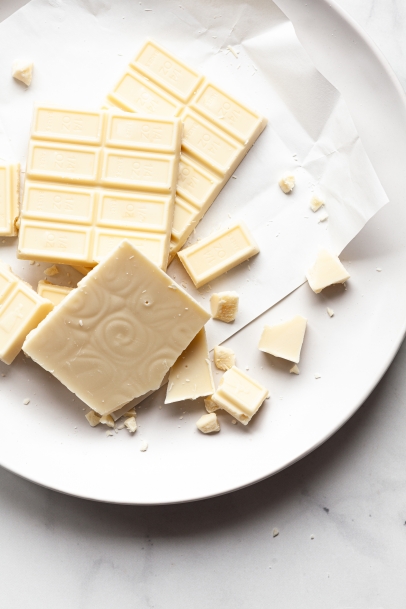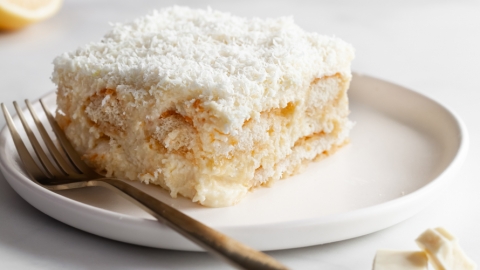White Chocolate
Chocolate is a topic of both love and division; there are those boldly enamoured with dark and others with a devout affection for milk. However, if you come across a white chocolate aficionado, you’ll likely be met with a swoony tone as they describe in great detail what they love about it. Buttery, sweet and sublimely smooth, devotees consider it unrivalled in the world of chocolate.
Made from the same cacao beans as milk and dark, white chocolate is unique in that it lacks one major component: cocoa solids. Unlike darker varieties, white chocolate bypasses the processing step where cocoa solids (cocoa liquor) are added back to cocoa butter. The complete absence of cocoa liquor gives white chocolate its beautiful ivory colour and, because the cocoa butter is unimpeded by solids, its texture is that of unparalleled silkiness. Sweet with hints of cocoa, fresh milk and vanilla, white chocolate is perfect for those preferring a milder chocolate without the bitterness and caffeine associated with other varieties.
Like many great discoveries, white chocolate was produced by mistake, with historians generally crediting the Swiss company Nestlé with its creation. Rather than the nutritional beverage they intended to make, experimentation with an excess of milk powder and cocoa butter resulted in what would become the first commercially available white chocolate bar in the 1930s. While it gained popularity in the Europe, primarily as white coat candy, it wasn’t until the mid-1940s that white chocolate was introduced to North America. Currently, white chocolate makes up roughly 10% of the global chocolate market, and though it may not be as popular as dark or milk, it certainly has its dedicated fans.
Yet many would argue that white chocolate isn’t real chocolate; cocoa connoisseurs will assert it’s merely sweetened fat, lacking the robust complexities of dark or milk, or that it doesn’t meet the characteristics that legally define chocolate. However, in 2002, North American and European regulatory bodies established manufacturing standards that granted white chocolate a certain status among its peers. To be considered real white chocolate, a minimum of 20% cocoa butter, 14% milk powder and 3.5% milk fat must be present. Nevertheless, whether white chocolate is genuine chocolate still remains largely debated.
As a self-confessed chocoholic, I can appreciate good chocolate no matter the type; however, it takes a discerning palate to recognize quality. Any white chocolate worth its weight is going to not only meet the regulatory criteria above (read the label), it’s also going to taste exceptionally creamy and melt effortlessly in your mouth. White chocolate should be ivory in colour, not white, and have a delicate vanilla and milky aroma with subtle hints of cocoa. Products cut with vegetable or palm oils will compromise the texture and taste, leading to a grainy or waxy mouthfeel. Fortunately, many chocolatiers are turning their focus to creating exemplary white chocolate for a growing market of refined taste buds.
If its delicate flavour and velvety texture wasn’t enough to love, white chocolate is the epitome of versatility, a true blank canvas from which an astonishing number of flavours can be incorporated. Common pairings like citrus, dried fruit, nuts, honey, matcha or coffee will uplift, balance and complement white chocolate mousse, truffles, bonbons or soufflé. By itself, it can enhance a simple date-night snack board accompanied by a glass of local Chardonnay. For those with a more adventurous palate, pair white chocolate with pungent and sharp blue cheese or caviar—an unexpected pairing that works immaculately thanks to a natural compound called trimethylamine.
However you choose to enjoy it, white chocolate will surely evoke a sense of luxury, perfect for celebrating your valentine or just because—you don’t need an elaborate reason to indulge!






